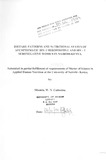| dc.description.abstract | A clinic based five months cross-sectional, but comparative study was carried
out on 204, randomly selected asymptomatic HIV Seropositive (cases) and my
Seronegative (controls) in a health facility in a Nairobi maternal child health
clinic. The aim of the study was to establish dietary patterns among my
seropositive and HIV seronegative women enrolled in a longitudinal cohort
study ..
Data was collected using a structured questionnaire.: focus group discussions,
anthropometric measurements and analysis of blood for the determination of
my status, haemoglobin levels and CD4 +/CD8 + absolute cell counts and ratios
respectively. Nutritional status was determined using Body mass index, Midupper
arm circumference, Subscarpula skinfold thickness, Triceps skinfold
thickness and haemoglobin levels. Nutrient adequacy of diets consumed by
respondents was computed using food frequency method, where different
combinations of responses were used to calculate indices of proteins, vitamins,
carbohydrates, and fat consumption. These indices were then compared, to the
recommended number of servings of various foods per day considered adequate
as suggested by the daily food guide.
The results show that the study group was relatively young, mean age 30 years,
with the mean age of index child 1.87 years (s.d 0.46). The majority, in both the
cases and controls, about 48% and 60.8% respectively were married. About
57.8% cases and 52.9% controls had attained primary school education. In total
about a third 30.4% of the respondents were self employed. This accounted for
28.4% cases and 32.4% controls. The type of activities the respondents were
engaged in, were mainly petty businesses such as hawking or food vending. The
majority in both cases and controls were in the middle income group according
to the Government of Kenya income classification 1994 (earned less than Kshs.
2,500 per month equivalent to US $ 45).
The diets consumed for both cases and controls were deficient in proteins and
carbohydrates but were relatively adequate in vitamins and fats. The differences
in both cases and controls were however not statistically significant .The
morbidity prevalence was also quite high among the cases and controls with
cough being the most prevalent condition, this was found to be significantly
related to the nutritional status for both study groups (p<O.OOl).
Apart from Body mass index, all other nutritional status indices showed
statistically significant differences with mv status. Using Mid-upper arm
circumference(cut off-point <28.5 em- 90% standard),about 7.7% cases and
2.0% controls were malnourished while using Subsarpula skinfold thickness (cut
off- point <13.7mm -90% standard),a higher proportion 39.2% and 30.4% of .
cases and controls respectively were malnourished. Approximately 30.4% and
26.5% of cases and control respectively fell below the Triceps skinfold
thickness(cut off-point <16.5mm). A high proportion of cases also 52.0% fell
below the Haemoglobin (cut off- point <12 g/dl for anaemia) as compared to
48% for controls. In each of the stated instances, the differences were statistically
significant for cases and controls. The results show that mv status is likely to
affect nutritional status even at an early phase of the disease.
The factors associated with poor nutritional status (p< 0.05) were Subscarpuar
skinfold thickness, Mid-upper. arm circumference, Triceps skinfold
thickness, Haemoglobin levels(Anaemia), education in years, lack of
nutritional counselling and constraints in dietary planning. Nutritional
knowledge and the dietary patterns between the two groups generally compared
well and there were no statistical significant differences noted in the two study
groups.
This study has established that poor nutritional status, lack of nutritional
counselling, low education levels, low social economic capability among other
factors are associated with malnutrition in asymptomatic mv seropositive and
HIV seronegative women. The recommendations are that aggressive nutritional
intervention in form of adequate nutritional counselling at the asymptomatic
phase 'With support of income generating activities would be key strategies to
achieve early dietary intervention, to counteract disease related malnutritional
manifestations that may, compromise on the nutritional status and increase the
cost of healthcare which is a limiting factor among the low income group hence
reduce maternal morbidity and mortality. | en |

